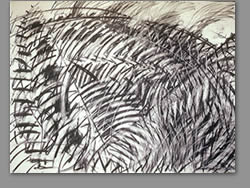
". . . . . a committed and exposed courage, a bravura of rare nerve. . confounds the normal visual expectation of spatial experience in a painting. . . intuitive invention and rapid mark-making drive the work. . . His speed of action allows him to cut through the'good taste barrier' . . . ( his work ) projects a serenity despite its surface buy-ness. "
Cuillin Bantock 2001
"His acrylic canvases are concerned above all with paint - its colour, how it sits on the canvas, how it throws back light. . . The result ( of his technique ) is a complex series of marks like leaves or motes of dust in sunlight. Thick, sensual, squidgy areas of paint are counterpointed against thin dry stripes. . . . . a Matissean love of patterning. "
Sue Hubbard 2003
. . . . . . fractal architectures of fluid dynamics like flocks of starlings, swirling atoms or swarms of polychrome insects. Boyd's paintings are as irrevocable and coherent as the curve of a wave crashing onto the shore, . . . . . . "
Richard Dyer 2009
The sheer scale of the Central African landscape, experienced by Graham Boyd during a two year stay in what was then Southern Rhodesia (now Zimbabwe) in the early 1950s had a profound impact on his perception of space and its representation.
Having studied illustration he began to evolve first into a figurative and landscape painter only to become increasingly aware of form and colour as expressive means in their own right. Inevitably he was drawn to 20th century modernism and the pragmatic development of Piet Mondrian's early abstraction.
Once back in the U. K. , he lived and worked in near derelict studios in Bushey, Hertfordshire that had been built by Sir Hubert von Herkomer R. A. in the 1890s for his followers and former students. The huge skylight leaked but gave the interior it's stunning luminosity, which along with space and off beaten track feel, made it an ideal working environment. He soon arrived at a form of abstraction which owed its origins to the repetitive mark-making of the Impressionists as well as the plus/minus glyphs and ciphers in Mondrian's Pier and Ocean series.
Working in adjacent studios were other young artists such as Gwyther Irwin, Ralph Rumney and the New Yorker Robert Moscowitz, all of whom were caught up in that creative spirit which seemed to define the sixties.
During this period he showed at the Waddington Gallery, A. I. A. , the Molton and Lords Galleries as well as being selected for the first ever John Moores Exhibion in Liverpool 1957,The Walker Gallery subsequently purchased his wood and canvas relief 'Nation'.
During a year in the early seventies whilst on a teaching exchange programme at the University of New Hampshire, he made a trip with his family in a VW Beetle to the West. It was the year of the Energy Crisis and there was a speed limit of 55 mph, so plenty of time to absorb the space and often dramatic natural phenomena as they sauntered through the vast landscape all the way to the Grand Canyon.
An experience which endorsed an all important sense of scale initiated by those ever distant horizons of Central Africa.
In 1976 he was appointed as Head of Painting at the Hertfordshire College of Art and Design, St. Albans. As a principal Lecturer he led the team responsible for developing a unique part-time mode of a B. A. Hons. Fine Art Degree Course specially designed to meet the needs of mature students.
For the past four decades he has worked from his Chipperfield studio, attending artists workshops and symposiums in, New York, 1983, Barcelona 1987, and The Azores 1997, working with an international cross - section of painters, sculptors and other media artists, such as Anthony Caro and Larry Poons. Also the critics, Clement Greenberg, Michael Fried and Karen Wilkin.
Despite his long term involvement with abstraction, he has continuously been fascinated by the dramas of cause and effect in natural phenomena. Formerly a keen climber and hill walker, he has made frequent visits to Snowdonia, the Scottish Highlands and the Cornish and Pembrokeshire coasts. In his work he has absorbed his experiences seeking equivalence rather than direct representation.
He continues to exhibit widely and frequently. His work is to be found in both public and private collections in the U. K. and abroad.



